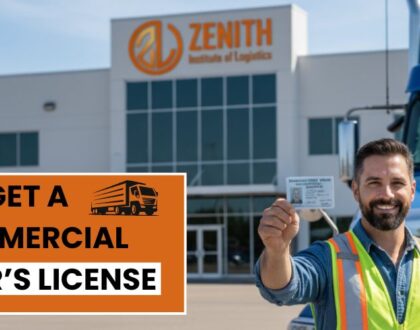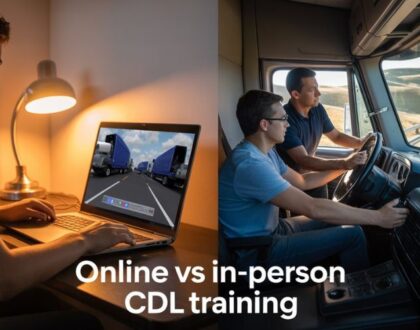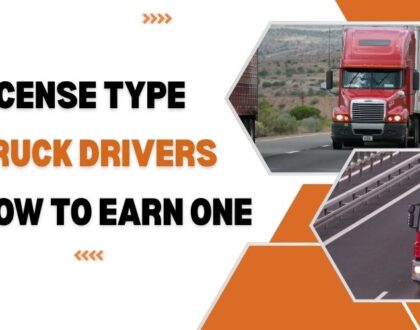How to Navigate the Commercial Driver License (CDL) Process

Obtaining a Commercial Driver’s License (CDL) can be challenging without proper guidance. Understanding the process is crucial, whether you aspire to become a professional truck driver or start your own transportation business. This guide will explain what a CDL is, its different types, and the essential steps to earning your license.
What is a CDL?
A CDL is a specialized license that grants drivers legal authority to operate large, heavy, or hazardous-material-carrying vehicles for commercial purposes. These vehicles include tractor-trailers, dump trucks, passenger buses, and tankers.
There are three main CDL classifications:
- Class A: Required for operating vehicles with a combined weight of 26,001 pounds, such as tractor-trailers and tankers.
- Class B: Required for single vehicles weighing 26,001 pounds or more, including buses and dump trucks.
- Class C: Required for smaller vehicles designed to transport hazardous materials or 16+ passengers.
Whether you plan to work for a logistics company or start a trucking business, the right CDL is essential for career advancement.
Steps to Obtaining a CDL
1. Research State-Specific CDL Requirements
CDL regulations vary by state, so it’s essential to check the specific requirements in your area. However, general eligibility criteria typically include:
- Minimum age of 18 for intrastate driving or 21 for interstate driving.
- Possession of a valid driver’s license.
- Proof of U.S. citizenship or lawful residency.
- Medical clearance through a physical examination.
Local trucking schools can guide state-specific regulations and help you navigate the application process.
2. Prepare for the CDL Written Knowledge Test
The first step in obtaining your CDL is passing the written knowledge test, which assesses your understanding of commercial driving rules, regulations, and vehicle operation. Topics typically include:
- Traffic laws for commercial vehicles.
- Safe driving practices.
- Vehicle inspection procedures.
Tips for Success:
- Enroll in CDL courses: Training programs offer structured learning to help you grasp the material.
- Use study guides: State CDL manuals and practice tests are valuable resources.
- Consider truck driving school: Professional instructors can boost your confidence and preparation.
3. Take the CDL Road Test
Once you pass the knowledge test, you must demonstrate your ability to operate a commercial vehicle safely and efficiently. The road test typically consists of:
Vehicle Inspection
Before driving, you must perform a pre-trip inspection to confirm the vehicle’s safety. This includes checking:
- Tires and brakes.
- Lights and reflectors.
- Fluid levels and hoses.
Road Driving Skills
During the road test, examiners will assess your ability to:
- Maneuver through traffic.
- Execute proper turns and navigate intersections.
- Perform parking and backing-up techniques.
Many CDL training programs offer hands-on practice to help refine these skills.
4. Submit Medical Forms
CDL applicants must meet physical health standards to ensure they can safely operate commercial vehicles. This requires:
- Completing a Department of Transportation (DOT) physical exam.
- Submitting a Medical Examination Report Form and Medical Examiner’s Certificate.
This ensures that drivers are physically fit for the demands of commercial driving.
5. Obtain a Commercial Learner’s Permit (CLP)
Before acquiring a full CDL, applicants must first earn a Commercial Learner’s Permit (CLP) by:
- Passing knowledge tests specific to the desired CDL class.
- Holding the CLP for a minimum of 14 days for hands-on experience.
Many CDL training programs include practical lessons to help candidates prepare for this stage.
6. Pass the Final Vehicle Inspection & Road Test
The last step involves:
- Vehicle Inspection: A detailed assessment to ensure the truck is roadworthy.
- Road Test: A practical driving evaluation under real-world conditions.
Completing these steps paves the way for a commercial driving career.
Also Read: How Long Does It Take to Get a CDL
Conclusion
Earning a CDL may seem complex, but with proper preparation and support, it can be a smooth and successful process. From researching state requirements to passing tests, each step plays a vital role in building a solid foundation for a trucking career.
Enrolling in a reputable trucking school and participating in CDL training programs can help you gain the necessary skills, boost your confidence, and achieve your goal of becoming a professional driver.
At Zenith Logistics Institute, we provide all the tools and knowledge needed to help you succeed. Our CDL training programs prepare you to pass your tests and embark on a rewarding trucking career.
Recommended Posts

How to Get a Commercial Driver’s License?
October 30, 2025

Online vs In-Person CDL Training: Pros and Cons
September 19, 2025


